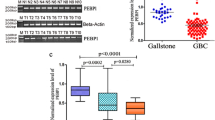Abstract
Purpose
Data related to the role of epigenetic modifications in gallbladder carcinoma (GBC) is limited. We intended to assess the role of crucial epigenetic modifiers pertaining to histone modification and DNA-methylation system in gallbladder carcinogenesis.
Methods
The expression of EZH2, H3K27me3, and DNA methyltransferases (DNMTs) was analyzed by immunohistochemistry in cases of GBC (n = 39), gallbladder dysplasia (GBD, n = 12), and benign mucosa (BM, n = 16). A semi-quantitative scoring system was used for assessing the immunohistochemical expression.
Results
The expression of EZH2 was significantly higher in cases of GBC than GBD (p value 0.001). The cases of BM were negative. Its expression was also higher in poorly differentiated tumors and positively correlated with the proliferative activity (MIB-1 labeling index) (p value 0.03 and 0.01, respectively). There was no significant difference in the expression levels of H3K27me3, DNMT-1, and DNMT-3B among GBC, GBD, and BM cases. Although GBC cases with strong EZH2 expression showed a shorter overall survival, the difference was not statistically significant.
Conclusion
This study highlights the crucial role of the key epigenetic regulators EZH2 in the pathobiology and evolution of gallbladder carcinogenesis. Given the reversibility of epigenetic alterations, EZH2 may be a novel therapeutic target for gallbladder carcinogenesis.


Similar content being viewed by others
References
Rawla P, Sunkara T, Thandra KC, Barsouk A. Epidemiology of gallbladder cancer. Clin Exp Hepatol. 2019;5(2):93–102.
Kim YJ, Kim K. Conditional survival in patients with gallbladder cancer. Chin J Cancer. 2017;36(1):85.
Margueron R, Reinberg D. The polycomb complex PRC2 and its mark in life. Nature. 2011;469(7330):343–9.
Robertson KD. DNA methylation, methyltransferases, and cancer. Oncogene. 2001;20(24):3139–55.
Kleer CG, Cao Q, Varambally S, Shen R, Ota I, Tomlins SA, et al. EZH2 is a marker of aggressive breast cancer and promotes neoplastic transformation of breast epithelial cells. Proc Natl Acad Sci U S A. 2003;100(20):11606–11.
Raman JD, Mongan NP, Tickoo SK, Boorjian SA, Scherr DS, Gudas LJ. Increased expression of the polycomb group gene, EZH2, in transitional cell carcinoma of the bladder. Clin Cancer Res. 2005;11(24 Pt 1):8570–6.
Toll AD, Dasgupta A, Potoczek M, Yeo CJ, Kleer CG, Brody JR, et al. Implications of enhancer of zeste homologue 2 expression in pancreatic ductal adenocarcinoma. Hum Pathol. 2010;41(9):1205–9.
Varambally S, Dhanasekaran SM, Zhou M, Barrette TR, Kumar-Sinha C, Sanda MG, et al. The polycomb group protein EZH2 is involved in progression of prostate cancer. Nature. 2002;419(6907):624–9.
Weikert S, Christoph F, Köllermann J, Müller M, Schrader M, Miller K, et al. Expression levels of the EZH2 polycomb transcriptional repressor correlate with aggressiveness and invasive potential of bladder carcinomas. Int J Mol Med. 2005;16(2):349–53.
Lee HW, Choe M. Expression of EZH2 in renal cell carcinoma as a novel prognostic marker. Pathol Int. 2012;62(11):735–41.
Sudo T, Utsunomiya T, Mimori K, Nagahara H, Ogawa K, Inoue H, et al. Clinicopathological significance of EZH2 mRNA expression in patients with hepatocellular carcinoma. Br J Cancer. 2005;92(9):1754–8.
Han Li C, Chen Y. Targeting EZH2 for cancer therapy: progress and perspective. Curr Protein Pept Sci. 2015;16(6):559–70.
Fattahi S, Golpour M, Amjadi-Moheb F, Sharifi-Pasandi M, Khodadadi P, Pilehchian-Langroudi M, et al. DNA methyltransferases and gastric cancer: insight into targeted therapy. Epigenomics. 2018;10(11):1477–97.
Gnyszka A, Jastrzebski Z, Flis S. DNA methyltransferase inhibitors and their emerging role in epigenetic therapy of cancer. Anticancer Res. 2013;33(8):2989–96.
Ding WJ, Fang JY, Chen XY, Peng YS. The expression and clinical significance of DNA methyltransferase proteins in human gastric cancer. Dig Dis Sci. 2008;53(8):2083–9.
He LJ, Cai MY, Xu GL, Li JJ, Weng ZJ, Xu DZ, et al. Prognostic significance of overexpression of EZH2 and H3k27me3 proteins in gastric cancer. Asian Pac J Cancer Prev. 2012;13(7):3173–8.
Niwa T, Tsukamoto T, Toyoda T, Mori A, Tanaka H, Maekita T, et al. Inflammatory processes triggered by Helicobacter pylori infection cause aberrant DNA methylation in gastric epithelial cells. Cancer Res. 2010;70(4):1430–40.
Yamaguchi J, Sasaki M, Harada K, Zen Y, Sato Y, Ikeda H, et al. Papillary hyperplasia of the gallbladder in pancreaticobiliary maljunction represents a senescence-related lesion induced by lysolecithin. Lab Investig. 2009;89(9):1018–31. https://doi.org/10.1038/labinvest.2009.65.
Yamaguchi J, Sasaki M, Sato Y, Itatsu K, Harada K, Zen Y, et al. Histone deacetylase inhibitor (SAHA) and repression of EZH2 synergistically inhibit proliferation of gallbladder carcinoma. Cancer Sci. 2010;101(2):355–62.
Liu DC, Yang ZL. Overexpression of EZH2 and loss of expression of PTEN is associated with invasion, metastasis, and poor progression of gallbladder adenocarcinoma. Pathol Res Pract. 2011;207(8):472–8.
Lin B, Hong H, Jiang X, Li C, Zhu S, Tang N, et al. c-Jun suppresses the expression of WNT inhibitory factor 1 through transcriptional regulation and interaction with DNA methyltransferase 1 in gallbladder cancer. Mol Med Rep. 2018;17(6):8180–8.
Srivastava K, Srivastava A, Mittal B. DNMT3B-579 G > T promoter polymorphism and risk of gallbladder carcinoma in North Indian population. J Gastrointest Cancer. 2010;41(4):248–53.
Honeywell RJ, Sarkisjan D, Kristensen MH, de Klerk DJ, Peters GJ. DNA methyltransferases expression in normal tissues and various human cancer cell lines, xenografts and tumors. Nucleosides Nucleotides Nucleic Acids. 2018;37(12):696–708.
Acknowledgments
The authors are thankful to all the technical staff specially Mr. S Raheman for the technical supports.
Author information
Authors and Affiliations
Corresponding author
Ethics declarations
Conflict of Interest
The authors declare that they have no conflict of interest.
Additional information
Publisher’s Note
Springer Nature remains neutral with regard to jurisdictional claims in published maps and institutional affiliations.
Gayatri Behera and Suvradeep Mitra share the first authorship.
Rights and permissions
About this article
Cite this article
Behera, G., Mitra, S., Mishra, T.S. et al. Enhancer of Zeste Homolog 2 (EZH2) in Malignant Progression of Gallbladder Carcinoma. J Gastrointest Canc 52, 1029–1034 (2021). https://doi.org/10.1007/s12029-020-00536-3
Accepted:
Published:
Issue Date:
DOI: https://doi.org/10.1007/s12029-020-00536-3




